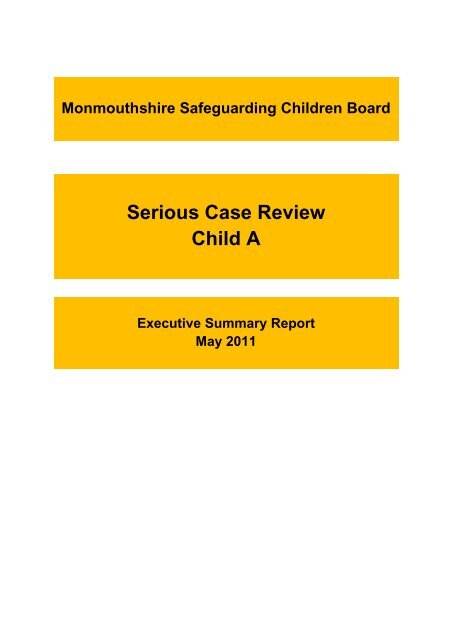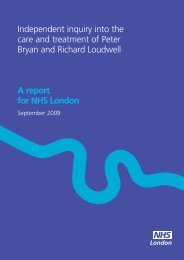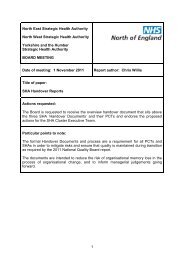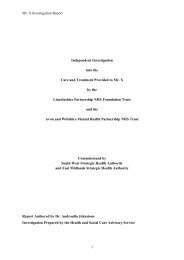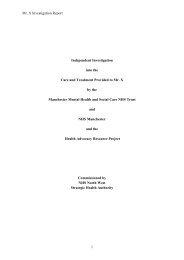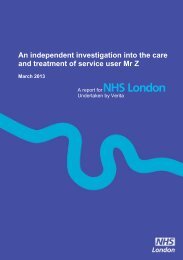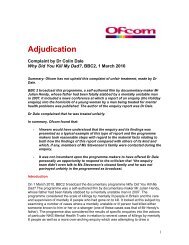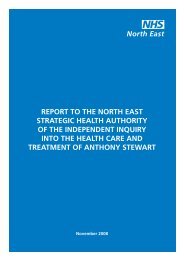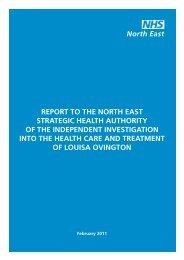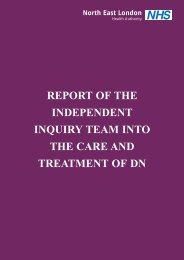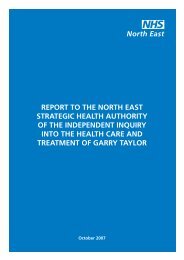Serious Case Review Child A - Hundred Families
Serious Case Review Child A - Hundred Families
Serious Case Review Child A - Hundred Families
You also want an ePaper? Increase the reach of your titles
YUMPU automatically turns print PDFs into web optimized ePapers that Google loves.
Monmouthshire Safeguarding <strong>Child</strong>ren Board<br />
<strong>Serious</strong> <strong>Case</strong> <strong>Review</strong><br />
<strong>Child</strong> A<br />
Executive Summary Report<br />
May 2011
2 | P age
1. Reason for the <strong>Review</strong><br />
1.1 <strong>Child</strong> A was born on 24 th November 2009. She lived with her Mother in a flat<br />
in Monmouthshire and was a healthy, well cared for child who was meeting<br />
her developmental milestones<br />
1.2 In the early hours of 20 th November 2010 Gwent police were telephoned by a<br />
person stating they were concerned for the welfare of <strong>Child</strong> A’s mother as she<br />
had just spoken to her and she had stated she felt like dying. The caller also<br />
stated she had seen <strong>Child</strong> A’s mother earlier that day and that she was<br />
concerned about her.<br />
1.3 As a result of the call the Police visited the home and spoke to the mother.<br />
<strong>Child</strong> A was seen and found to be sleeping in a well kept, tidy flat. Mother<br />
stated she had trouble sleeping over the previous few nights which had left<br />
her feeling emotional and tearful. Avenues for support were discussed and the<br />
police left with Mother saying that she intended to retire to bed for the evening<br />
and seek advice in the morning. The police were satisfied that no further<br />
immediate action was required and made a referral to social services for a<br />
follow up assessment.<br />
1.4 At 05.34a.m on the same day a telephone call was received from Mother<br />
stating that she had stabbed her baby. Police attended and found <strong>Child</strong> A<br />
deceased with multiple stab wounds. Mother was arrested for murder.<br />
1.5 Monmouthshire Local Safeguarding <strong>Child</strong>ren’s Board met on 25 th November<br />
2010 and agreed that a <strong>Serious</strong> <strong>Case</strong> <strong>Review</strong> would be undertaken.<br />
2. Process of the <strong>Review</strong><br />
<strong>Serious</strong> <strong>Case</strong> <strong>Review</strong> Panel<br />
2.1 The <strong>Serious</strong> <strong>Case</strong> <strong>Review</strong> Panel was Chaired by the Head of <strong>Child</strong>ren’s<br />
Services for Blaenau Gwent County Borough Council. He has significant<br />
3 | P age
4 | P age<br />
experience at all professional and managerial levels in children’s social<br />
services. In addition the Panel members comprised:<br />
<strong>Child</strong> Protection Coordinator, Monmouthshire <strong>Child</strong>ren’s Services<br />
Named Nurse, <strong>Child</strong> Protection, Aneurin Bevan Health Board<br />
Detective Inspector, Heddlu Gwent Police<br />
Designated Nurse, <strong>Child</strong> Protection, Public Health Wales<br />
The Panel was administered by the LSCB Administrator for Monmouthshire<br />
and Torfaen.<br />
The Overview Report Writer<br />
2.2 Martin Price is a qualified social worker with 35 years experience in statutory<br />
children’s services. He has worked in different settings and at all staff and<br />
managerial levels, in a number of local authorities in Wales; for CAFCASS<br />
Cymru; and for CSSIW. Since March 2006 he has worked as an independent<br />
social work professional and management consultant. He has experience of<br />
undertaking serious case reviews as the Chair of an ACPC, as chair of<br />
serious case review panels, as a writer of individual management reports and<br />
as a writer of overview reports.<br />
Individual Management <strong>Review</strong>s<br />
2.3 The three main agencies involved with Mother and <strong>Child</strong> A undertook<br />
individual reviews and provided reports of the findings. The reports were<br />
comprehensive and fully considered issues relevant to respective agencies.<br />
Meeting of the Panel<br />
2.4 The Panel met on the following dates-<br />
2 nd December 2010<br />
11 th January 2011<br />
3 rd March 2011<br />
1 st April 2011<br />
6 th May 2011<br />
The Panel received very efficient support from the LSCB Administrator.<br />
2.5 The detailed terms of reference of the review are set out in Appendix 1
1. Overview Findings<br />
3.1 Mother’s actions in causing the death of <strong>Child</strong> A were not preceded by any<br />
concerns about her ability to safely care for her child. She had experienced<br />
difficulties as an adolescent and as a young adult and had been diagnosed as<br />
having periodical symptoms of depression but there is no evidence that this<br />
undermined her functioning as an adult and a mother.<br />
3.2 Mother’s is described as an intelligent, very pleasant, and hard working young<br />
woman who had engaged well with the supportive agencies and managed her<br />
daily life reasonably well. On two very different occasions Mother and her<br />
child had come to the attention of Police and Social Services but neither event<br />
raised concerns about the parenting provided to <strong>Child</strong> A. Mother’s episodes of<br />
depression that were treated appropriately and she had been offered further<br />
help.<br />
3.3 Whilst <strong>Child</strong> A was clearly the victim of non-accidental injuries which were the<br />
immediate cause of her death, there were no prior child protection issues or<br />
historical concerns about Mother’s care for her child. The Police had called at<br />
the house four hours before the fatal incident and the referral they made for a<br />
follow up assessment in relation to <strong>Child</strong> A was appropriate. There was no<br />
evidence to suggest they should be concerned for her immediate welfare.<br />
3.4 It is not the purpose of a <strong>Serious</strong> <strong>Case</strong> <strong>Review</strong> to provide a comprehensive<br />
overview of formal research linked to the nature or circumstances of the harm<br />
suffered by a child. However, cases of filicide like that of <strong>Child</strong> A are relatively<br />
rare and present professionals and the public with a challenge of<br />
understanding. For this reason an indicative research view is set out briefly in<br />
Appendix 2 below. The contents of the appendix should be viewed as<br />
indicative but not of the standard of a research paper nor as a comprehensive<br />
overview the issues.<br />
5 | P age
3.5 In conclusion there were no predictive factors known to statutory agencies<br />
that suggested that <strong>Child</strong> A was at risk of harm from her mother. Mother was<br />
like many young people who had struggled in adolescence and found<br />
themselves managing the responsibilities of parenthood at an early age.<br />
Agencies appropriately shared information when there was a need to do so<br />
and there was good inter-agency working by professionals involved with the<br />
family which did not indicate <strong>Child</strong> A as being in need of protection.<br />
3.6 It is inevitable that when agencies critically examine their historical<br />
involvement with a family, areas of policy, process and / or practice issues are<br />
identified as requiring review or improvement. Individual agencies have made<br />
recommendations to address these. The issues identified are not linked to the<br />
death of <strong>Child</strong> A. This overview report does not make any further<br />
recommendations.<br />
6 | P age
Appendix 1- Terms of Reference<br />
Aim of the Individual Agency <strong>Review</strong>:<br />
To look openly and critically at individual and organisational practice to see<br />
whether the case indicates that changes in practice and inter agency working<br />
could and should be made and if so, to identify how these changes will be brought<br />
about.<br />
Specific Terms:<br />
To establish the agency involvement with the child and family by:<br />
Constructing a comprehensive chronology of involvement by the agency and / or<br />
professional(s) in contact with the child and family over the period of time specified in<br />
these terms of reference. Period of review is from 2 nd February 2009 to the time of<br />
HR’s death.<br />
(This chronology should include decisions reached, services offered and / or<br />
provided to the children and family and other action taken)<br />
To analyse the involvement of the agency with the child and family to establish:<br />
a) Whether practitioners were sensitive to the needs of the child in their work<br />
and the well being of the mother and about what to do if they had concerns<br />
b) Whether the agency had in place policies and procedures for safeguarding<br />
children and acting on concerns about their welfare and whether these were acted<br />
upon in this case.<br />
c) Whether key relevant points / opportunities for assessment and decision making in<br />
this case, in relation to the child and family were taken.<br />
d) Whether assessments and decisions were reached in an informed, timely and<br />
professional way<br />
e) Whether actions were carried out in a timely way and accorded with assessments<br />
and decisions made.<br />
f) Whether there was an appropriate level of parental consultation and participation<br />
7 | P age
g) Whether practice was sensitive to the racial, cultural, linguistic and religious<br />
identity of the child and family<br />
h) Whether senior managers, or other agencies and professionals, were involved<br />
where they should have been<br />
i) Whether the work in this case was consistent with Monmouthshire LSCB’s policy<br />
and procedures for safeguarding children and wider professional standards<br />
j) Whether appropriate care plans were in place.<br />
Particular issues for this case in relation to the points above are;<br />
Consider whether agency responses were appropriate to the mothers<br />
presenting mental health issues.<br />
Mother’s possible vulnerability and how universal services engaged with her<br />
To identify any lessons learned from the case:<br />
a) Are there lessons to be learned from this case with regard to the way in which the<br />
agency works to safeguard children and promote their welfare?<br />
b) Is there good practice to highlight, as well as ways in which practice can be<br />
improved?<br />
c) Are there implications for ways of working; training (single and inter – agency);<br />
management and supervision; working in partnership with other agencies;<br />
resources?<br />
To make recommendations for action in relation to:<br />
a) What action should be taken by whom and by when?<br />
b) What outcomes should these actions bring about?<br />
c) How the agency will review whether the proposed actions have been achieved?<br />
Aim of the LSCB Overview Report:<br />
The overview report should bring together and relate the information and analysis<br />
contained in the individual agency reviews and if appropriate the views and<br />
experiences of family members. in order to:<br />
Establish whether there are lessons to be learned from the case about the way in<br />
which local professionals and agencies work together to safeguard children<br />
Identify clearly what those lessons are, how they will be acted upon and what is<br />
expected to change as a result and<br />
8 | P age
Improve inter-agency working and safeguarding children<br />
Specific Terms<br />
In compiling the LSCB overview report, the Author will:<br />
Prepare an introduction that:<br />
i) Summarises the circumstances that led to the review being undertaken<br />
ii) States the Terms of Reference<br />
iii) Lists contributors to the review and the nature of their contributions<br />
iv) Lists the <strong>Serious</strong> <strong>Case</strong> <strong>Review</strong> panel and the Authors of the Agency Reports and<br />
the Overview Report<br />
Consider the facts of the case:<br />
i) Prepare a genogram showing membership of family, extended family and<br />
household<br />
ii) Compile an integrated chronology of involvement with the children and family on<br />
the part of all relevant agencies, professionals and others who have contributed to<br />
the review process, noting specifically each occasion when the child was seen<br />
iii) Prepare an overview which summarises what relevant information was known to<br />
the agencies and professionals involved, about the parents and the home<br />
circumstances of the child.<br />
Provide an analysis of the case that considers:<br />
i) How and why events occurred<br />
ii) The decisions that were made<br />
iii) The actions taken or not taken<br />
iv) Assess whether decisions and actions taken were in line with LSCB policies and<br />
procedures<br />
v) What services were provided in relation to decisions and actions in the case<br />
vi) Any reasons /underlying factors, which makes the case a cause for concern<br />
vii) Whether (with the benefit of hindsight) different decisions or actions may have led<br />
to an alternative course of events<br />
viii) Any examples of good practice<br />
9 | P age
ix) Any matters of relevance arising from case reviews of a similar nature conducted<br />
in other parts of the UK<br />
Provide written conclusions and recommendations that:<br />
i) Summarises what, if any are the lessons to be drawn from the case<br />
ii) Address how lessons may be translated into recommendations for action.<br />
iii) Provide an executive summary and conclusions<br />
Recommendations should:<br />
i) Be focused and specific and capable of being implemented<br />
ii) Highlight, where appropriate, issues for national, as well as local policy and<br />
practice.<br />
iii) Include recommendations made within individual agency review reports in<br />
addition to those made by the author of the overview report to the LSCB.<br />
10 | P age
Appendix 2 - The Research Context<br />
1. Bourget (2007) discusses the categorisation of filicide and includes a model<br />
that describes five major categories: pathological filicide, accidental filicide,<br />
retaliating filicide, neonaticide, and paternal filicide. In this model, pathological<br />
filicide refers to cases in which the perpetrator most likely has a major<br />
psychiatric illness. The filicide probably has psychotic or altruistic motives, and<br />
includes homicide-suicide events. Accidental filicide includes death due to<br />
various forms of child abuse, including battered-child syndrome and fabricated<br />
or induced illness. Retaliating filicide is the murder of a child to punish a<br />
spouse, while neonaticide is usually the result of an unwanted pregnancy.<br />
2. In their review of studies Bourget (2007) reports on the numerous reports of an<br />
association between filicide and pre-existing psychiatric disorders is<br />
compounded by indications that a significant number of homicidal parents come<br />
to the attention of psychiatrists or other health professionals before the offence.<br />
11 | P age<br />
Two studies indicate that filicidal parents’ most frequent reason for contacting<br />
agencies was concern over their mental health. One study found that nearly all<br />
of the psychotic women in their study were in ongoing psychiatric treatment at<br />
the time of the offence, and that significantly more psychotic women compared<br />
with non-psychotic women voiced concerns about their children to their family<br />
within two weeks before the offence.<br />
3. Friedman (2005) found that women at risk for neonaticide are often young and<br />
unmarried, deny or conceal the pregnancy, and lack prenatal care. The factors<br />
associated with maternal filicide appear to be nonspecific but seem likely to<br />
include past use of psychiatric services and a history of suicidality and<br />
depression or psychosis. However, the factors associated with maternal filicide<br />
are likely to be different for women who are psychiatrically ill, compared to those<br />
who are not psychiatrically ill.
4. Stroud (2008) comments that we know a great deal about the procedures<br />
aimed at protecting children but “the numerous public inquiries into child<br />
homicides within families, together with serious case reviews and analyses of<br />
these do not afford detailed understanding of child homicide as a phenomenon,<br />
nor of those who commit it: instead they offer in-depth information on the<br />
specific circumstances of specific cases, focusing on professional failures.<br />
Further, relatively little is known about the lives and pre-offence experiences of<br />
individuals who kill a child. Stroud states that it seems justified to conclude “that<br />
we cannot be sure how appropriately the policy focus of procedural<br />
requirements addresses the needs of, or risks posed by those who kill a child”.<br />
Stroud reports that three main themes emerge in relation to the pre-offence<br />
experiences of people who kill or seriously harm a child, namely, the presence,<br />
role and effects of psychological difficulties; difficulties in relationships across<br />
the lifespan or social isolation; heterogeneity in respect of stressful<br />
experiences. However, Stroud concludes that it is difficult to see current<br />
12 | P age<br />
policies, interventions and practices addressing the needs of those who kill a<br />
child. Further, given resource constraints on therapeutic interventions, it seems<br />
unlikely that such services will be easily accessible in the near future.<br />
References<br />
i) Bourget, Dominique. Grace, Jennifer. Whitehurst, Laurie (2007). A <strong>Review</strong><br />
of Maternal and Paternal Filicide. The Journal of the American Academy of<br />
Psychiatry and the Law 35:74–82<br />
ii) Friedman, Susan Hatters. Horwitz, Sarah McCue. Resnick, Phillip J (2005).<br />
<strong>Child</strong> Murder by Mothers: A Critical Analysis of the Current State of<br />
Knowledge and a Research Agenda. American Journal of Psychiatry<br />
162:1578-1587<br />
iii) Stroud, Julia.(2008) A psychosocial analysis of child homicide. Critical Social<br />
Policy 28: 482
13 | P age<br />
iv) Yarwood, David J (2004) “<strong>Child</strong> Homicide: <strong>Review</strong> of Statistics and Studies”.<br />
Dewar Research


